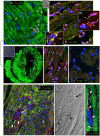Infarct-induced steroidogenic acute regulatory protein: a survival role in cardiac fibroblasts
- PMID: 23831818
- PMCID: PMC5415234
- DOI: 10.1210/me.2013-1006
Infarct-induced steroidogenic acute regulatory protein: a survival role in cardiac fibroblasts
Abstract
Steroidogenic acute regulatory protein (StAR) is indispensable for steroid hormone synthesis in the adrenal cortex and the gonadal tissues. This study reveals that StAR is also expressed at high levels in nonsteroidogenic cardiac fibroblasts confined to the left ventricle of mouse heart examined 3 days after permanent ligation of the left anterior descending coronary artery. Unlike StAR, CYP11A1 and 3β-hydroxysteroid dehydrogenase proteins were not observed in the postinfarction heart, suggesting an apparent lack of de novo cardiac steroidogenesis. Work with primary cultures of rat heart cells revealed that StAR is induced in fibroblasts responding to proapoptotic treatments with hydrogen peroxide or the kinase inhibitor staurosporine (STS). Such induction of StAR in culture was noted before spontaneous differentiation of the fibroblasts to myofibroblasts. STS induction of StAR in the cardiac fibroblasts conferred a marked resistance to apoptotic cell death. Consistent with that finding, down-regulation of StAR by RNA interference proportionally increased the number of STS-treated apoptotic cells. StAR down-regulation also resulted in a marked increase of BAX activation in the mitochondria, an event known to associate with the onset of apoptosis. Last, STS treatment of HeLa cells showed that apoptotic demise characterized by mitochondrial fission, cytochrome c release, and nuclear fragmentation is arrested in individual HeLa cells overexpressing StAR. Collectively, our in vivo and ex vivo evidence suggests that postinfarction expression of nonsteroidogenic StAR in cardiac fibroblasts has novel antiapoptotic activity, allowing myofibroblast precursor cells to survive the traumatized event, probably to differentiate and function in tissue repair at the infarction site.
Figures









References
-
- Silvestre JS , Robert V , Heymes C, et al. . Myocardial production of aldosterone and corticosterone in the rat. Physiological regulation. J Biol Chem. 1998;273:4883–4891. - PubMed
-
- Kayes-Wandover KM , White PC. Steroidogenic enzyme gene expression in the human heart. J Clin Endocrinol Metab. 2000;85:2519–2525. - PubMed
-
- Young MJ , Clyne CD , Cole TJ , Funder JW. Cardiac steroidogenesis in the normal and failing heart. J Clin Endocrinol Metab. 2001;86:5121–5126. - PubMed
-
- Gomez-Sanchez CE , Gomez-Sanchez EP. Editorial: Cardiac steroidogenesis—new sites of synthesis, or much ado about nothing? J Clin Endocrinol Metab. 2001;86:5118–5120. - PubMed
-
- Casal AJ , Silvestre JS , Delcayre C , Capponi AM. Expression and modulation of steroidogenic acute regulatory protein messenger ribonucleic acid in rat cardiocytes and after myocardial infarction. Endocrinology. 2003;144:1861–1868. - PubMed
Publication types
MeSH terms
Substances
LinkOut - more resources
Full Text Sources
Other Literature Sources
Medical
Research Materials

